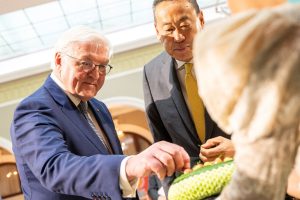After roughly five months in office, Thailand’s flamboyant Prime Minister Srettha Thavisin finally got to roll out the red carpet for his first official foreign visitor. And perhaps not on anybody’s bingo card, the first distinguished foreign guest was Frank-Walter Steinmeier, Germany’s current president and former foreign minister. His three-day trip from January 24 to 26 included an audience with Their Majesties the King and Queen of Thailand.
Although high-level visits between Thailand and Germany are nothing unique, as displayed by the “undemocratic” ex-Thai premier Gen. Prayut Chan-o-cha’s 2018 journey to meet former German Chancellor Angela Merkel, the last time a German president officially set foot in Bangkok was over two decades ago. Steinmeier’s grand arrival has therefore pulled back the curtain on the somewhat out-of-focus bilateral relationship.
The Thai-German relationship has been longstanding, dating back to the early phase of German unification under Prussia, and generally conflict-free, largely due to Germany’s lack of (or inability to pursue) colonial ambitions. Despite tensions amidst the Second World War, I’d argue that the only time Thai-German relations really turned sour was when Thailand (historically called Siam) made a strategic move to join the Allies against the Germany-led Central Powers during the First World War. This brought an end to Germany and Austria-Hungary’s extraterritorial rights in Thailand. Even so, ties were restored fairly quickly. By 1924, a provisional economic arrangement between the two nations was already in place.
Indeed, trade and investment have served as the core of the Thai-German partnership. The Germans notably played a pivotal part in Thailand’s postal and rail developments of the late 19th century, with a German engineer named Karl Bethge becoming the Thai state’s first railway commissioner. Today, Thailand holds significance as Germany’s 37th largest global trading partner in terms of turnover (combined exports and imports value) based on the 2022 data.
But Thailand’s trade connection to Germany still lags behind fellow Southeast Asian nations, namely Malaysia and Singapore. And because the Thai-German relationship has been quite free of drama, it has never featured much in history books and tends to fly under people’s radar.
The initial unexpectedness of the visit aside, Thailand’s growing proximity with Germany makes a lot of sense. After all, the two nations share more similarities than commonly thought. Both are major export-based nations in the heart of their respective regions, and key enablers of regional integration (See: “Thailand to become the Germany of Asia?”). Both are widely seen as reluctant U.S. allies, though to different degrees. Both arguably have less to lose should an armed conflict erupt in the Indo-Pacific, with Germany possessing no territorial holdings in the region and Thailand being a non-claimant state in a major flashpoint, and seem to envision an “inclusive” Indo-Pacific order that goes beyond the U.S.-China competition. Both have also sustained relatively close relations with China. And amid heightened geopolitical competition, both are recalculating their relations with China.
There are already plenty of discussions on Germany’s new China strategy. The bottom line is that Germany, in order to solidify a united EU stance on China (which is becoming more wary) and enhance the transatlantic bloc’s capacity to act, is looking to lower reliance on the Chinese market. Germany’s growing activities in Southeast Asia are a palpable reflection of this shift.
Thailand’s amicable relationship with China, meanwhile, remains as good as ever. But Thailand is simultaneously engaging more with Western nations following a prolonged period of military rule that – when labeling things black and white – was regarded as Beijing-aligned. Taking into account the Western sanctions imposed on Thailand after the 2014 coup, the China tilt was one of necessity and not of choice. Now, with a more welcoming global scene, Thailand has more room to pursue strategic hedging to avoid picking sides.
Despite the potential for enlarged cooperation, business prevails as the central theme of Thai-German cooperation. This is only logical given Germany’s limited political and security roles in Asia, and the Srettha government’s almost exclusively trade-oriented foreign policy. For Srettha, who’s also the finance minister, and his Pheu Thai Party, which markets itself on economic prowess, failure to stimulate Thailand’s sluggish economy would constitute a costly setback on the political front.
During their meeting on January 25, Srettha and Steinmeier expressed their intention to elevate Thailand-Germany relationship to a strategic partnership and discussed investment opportunities in mutually beneficial areas of railroad, education, renewable energy technologies and electric vehicles (EVs). The latter two, renewable energy systems and EVs, are well aligned with Germany’s newly adopted climate foreign policy. Facing threats to its food export industry from changing temperatures, Thailand has likewise signaled a stronger commitment to environmental conservation through the recent establishment of the Department of Climate Change and Environment.
Living up to his “salesman” persona, Srettha certainly didn’t miss the chance to promote his flagship (though unoriginal) “Land Bridge” initiative to construct a transport passage across the southern part of Thailand, ultimately creating an alternative shipping route to the Straits of Malacca. It’s yet to be determined how much investment the Germans are willing to pour into Thailand’s grand dream, but as experts foresee, Germany is likely to play a peripheral role in an infrastructure megaproject that has far-reaching social and environmental impacts.

































